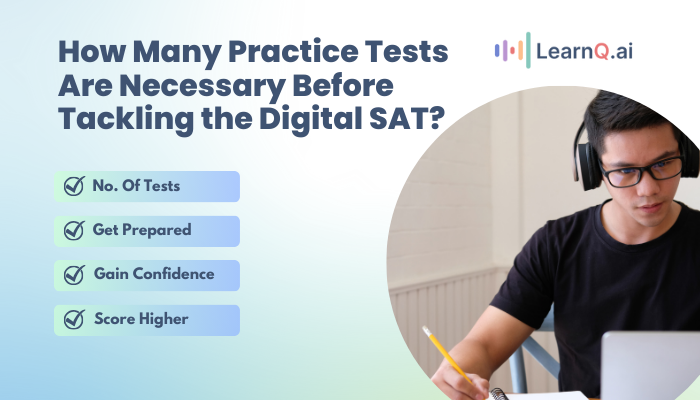The Digital SAT represents a significant shift from the traditional paper-based exam to a computer-based format. This modern version of the SAT is designed to be more accessible and user-friendly, with features such as a shorter test duration and the ability to take the exam on a personal or school-provided device.
The digital format aims to reflect the skills and knowledge that students need to succeed in college and beyond.
Key differences between traditional and digital SAT
The transition from the traditional SAT to the digital format brings several key changes. To help you understand these differences, here’s a comparative table:
| Feature | Traditional SAT | Digital SAT |
| Format | Paper-based | Computer-based |
| Duration | Approximately 3 hours | 2 hours 14 mins |
| Testing Approach | Fixed set of questions | Adaptive testing |
| Scoring | Results available in weeks | Results available in days |
| Test Experience | Same for all test-takers | Unique for each test-taker |
Importance of practice tests in preparing for the Digital SAT
Understanding the importance of practice tests for the digital SAT is crucial. Here are some key points that highlight their significance:
- Familiarization with Exam Format: Practice tests help students become familiar with the Digital SAT’s format, question types, and timing.
- Comfort with Digital Platform: Taking practice tests on a digital platform builds comfort and confidence with the technology and interface used on test day.
- Feedback on Performance: Practice tests provide valuable feedback on areas of strength and weakness enabling students to tailor their study strategies accordingly.
- Tailored Study Strategies: By identifying areas that need improvement, students can focus their study efforts more effectively.
- Boosted Confidence: Regular practice helps build confidence in handling the digital exam format, reducing test-day anxiety.
Understanding the Structure of the Digital SAT
Breakdown of sections in the Digital SAT
The Digital SAT consists of two main sections: Reading and Writing and Math. Each section is designed to assess a range of skills that are crucial for college and career readiness.
| Component | Time allotted | No of questions |
| Reading and Writing | 64 mins ( 2 modules, 32 minutes allotted to each module) | 54 |
| Maths | 70 mins (2 modules, 35 minutes allotted to each module) | 44 |
| Total | 134 | 98 |
Types of questions and skills assessed
The Reading and Writing section of the Digital SAT includes reading questions, which require citing evidence from passages, and words-in-context questions, which involve determining the meaning of words or phrases within the context of the passage.
In the Math section, questions cover a broad range of topics, including algebra, geometry, and data analysis. Want to know more about Maths Formula? Read this blog!
Timing and scoring system
The Digital SAT is shorter than the traditional SAT. The scoring system remains similar to the traditional SAT, with a total score range of 400 to 1600, split evenly between the Reading & Writing and Math sections. Each section is scored on a scale of 200 to 800, and there is no penalty for incorrect answers.
The Role of Practice Tests in SAT Preparation
Assessing readiness and identifying weaknesses
Practice tests for the digital SAT are an essential tool in assessing your readiness. By simulating the actual exam, they provide a realistic gauge of your current performance level.
Analyzing your practice test results can help you identify areas of weakness, allowing you to focus your study efforts more effectively. This targeted approach ensures that you address any gaps in knowledge or skills well before the actual test day.
Familiarizing with the digital test-taking environment
With the transition to the Digital SAT, familiarizing yourself with the digital test-taking environment has become more important than ever. Practice tests for the digital SAT offer the opportunity to navigate the digital interface, use the on-screen tools, and experience the adaptive nature of the exam.
This exposure can help reduce anxiety and build confidence, ensuring that you are comfortable and proficient with the digital format when it matters most.
Improving time management and test-taking strategies
Effective time management is crucial for success on the SAT. Practice tests for the digital SAT allow you to develop and refine your timing strategies, ensuring that you can complete each section within the allotted time.
Additionally, regular practice helps you hone your test-taking strategies, such as the process of elimination, educated guessing, and pacing. By integrating these techniques into your preparation routine, you can enhance your overall performance on the actual exam.
Determining the Number of Practice Tests Needed
Individual learning and preparation styles
The number of practice tests needed varies from student to student, as it depends on individual learning styles and preparation habits. Some students may benefit from taking numerous practice tests to build confidence and familiarity with the exam format, while others may focus more on targeted practice and review, requiring fewer full-length tests.
It’s important to find a balance that works for you, ensuring that you use practice tests for the digital SAT effectively without causing burnout.
Starting point: Assessing your initial practice test score
Your initial practice test score serves as a valuable starting point in determining how many additional tests you may need. By assessing your baseline performance, you can identify areas of strength and weakness that can guide your study plan.
If your initial score is significantly lower than your target score, you may need to take more practice tests for the digital SAT to monitor your progress and adjust your strategies accordingly.
Setting realistic goals based on desired score improvements
Setting realistic goals is crucial when planning the number of practice tests to take. Consider the amount of time you have before the actual SAT and the score improvement you aim to achieve.
If you’re aiming for a substantial score increase, you may need to take more practice tests to track your progress and ensure that your study efforts are paying off. However, it’s also important to avoid overloading yourself with too many tests, as the quality of review and reflection after each test is just as important as the quantity of tests taken.
Are you confused about which test to opt for? Sign up for free at LearnQ.ai! Try, and you will know what we are talking about.
Recommended Number of Practice Tests
General recommendations for a minimum number of practice tests
As a general guideline, it’s recommended that students take at least 3 to 5 full-length practice tests during their SAT preparation. This provides a sufficient baseline to assess initial strengths and weaknesses, track progress, and become comfortable with the test format and timing. However, this is just a starting point, and the actual number may vary depending on individual needs and goals.
Adjusting the number based on progress and confidence levels
The number of practice tests you take should be adjusted based on your progress and confidence levels. If you find that your scores are consistently improving and you feel confident in your abilities, you may not need to take as many tests.
On the other hand, if you need help to reach your target scores or feel uncertain about certain sections, additional practice tests can be beneficial. Regularly reassess your progress and adjust your study plan accordingly.
You can always get help from platforms like LearnQ.ai, where your personal AI tutor, Mia, will help you plan tests and strategize the next steps you need to take.
Quality over quantity: Focusing on learning from each practice test
While the number of practice tests for the digital SAT is important, it’s even more crucial to focus on the quality of your review and learning from each test. After completing a practice test, take the time to thoroughly review your answers, understand your mistakes, and identify patterns in your performance.
This reflective process is key to making meaningful improvements and getting the most out of each practice test. Remember, it’s not just about taking as many tests as possible, but about using each test as a learning opportunity to enhance your understanding and skills. Are you looking to brush up on your skills? Click here!
Balancing Practice Tests with Other Study Methods
Incorporating content review and targeted practice
While practice tests are a vital component of SAT preparation, it’s important to balance them with content review and targeted practice. Dedicate time to reviewing key concepts, formulas, and rules in each subject area.
Supplement this with targeted practice on specific topics or question types where you need improvement. This comprehensive approach ensures that you’re not only familiar with the test format but also have a strong grasp of the underlying material.
For Example, In the case of LearnQ.ai, you can always analyze your scores with the help of a Diagnostic test.
Using official SAT practice materials for accurate experience
To get the most accurate representation of the actual exam, it’s recommended to use official SAT practice materials. These resources, provided by the College Board, are designed to mirror the content, format, and difficulty level of the real test. Incorporating official practice questions and tests into your study routine can give you a more realistic understanding of what to expect on test day.
You can also use platforms like LearnQ.ai which focus on providing real-time insights into the strengths and weaknesses of students, as well as predicting their scores, making learning data-driven.
Scheduling regular practice tests to monitor progress
Regularly scheduled practice tests should be a key part of your study plan. They serve as benchmarks to monitor your progress and evaluate the effectiveness of your study strategies.
Aim to take a full-length practice test every few weeks, depending on your overall preparation timeline. This will help you track your improvements, adjust your study plan as needed, and build your stamina for the actual exam.
Final Tips for Maximizing Practice Test Efficacy
Simulating realistic test conditions during practice
To make the most of your practice tests, it’s important to simulate conditions that closely resemble the actual test environment. This means setting aside uninterrupted time, turning off distractions, and following the same time limits as the real exam.
By practicing under realistic conditions, you’ll be better prepared to handle the pressures of test day and perform at your best.
Reviewing and analyzing errors after each practice test
After completing a practice test, take the time to thoroughly review and analyze your errors. Understand why you got certain questions wrong, whether it was due to a misunderstanding of the concept, a careless mistake, or time management issues.
This analysis is crucial for identifying patterns in your errors and making targeted improvements in your study approach.
Incorporating breaks and maintaining a study schedule
While practice tests are an important part of your preparation, it’s essential to balance them with breaks and maintain a consistent study schedule. Overloading yourself with back-to-back practice tests for the digital SAT can lead to burnout and diminishing returns.
Instead, space out your practice tests and incorporate breaks to keep your mind fresh and focused. A well-structured study schedule that includes regular practice tests, content review, and relaxation time will help you stay motivated and make steady progress toward your goals.
Summing Up
Practice tests for the digital SAT are an indispensable tool in your Digital SAT preparation arsenal. They not only familiarize you with the exam format but also provide invaluable feedback to fine-tune your study strategy. As you embark on your SAT journey, consider incorporating LearnQ.ai into your study plan.
With its adaptive testing platform and comprehensive feedback system, LearnQ.ai offers a cutting-edge approach to SAT prep that can help you achieve your desired score with confidence. Start your path to success today by exploring the LearnQ.ai Digital SAT platform.
Searching for a full-length digital SAT practice set? Click here!











